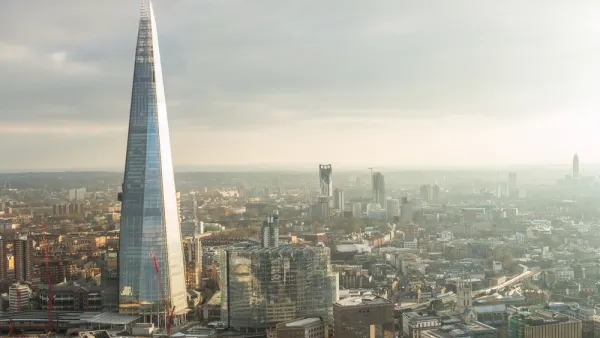"There is no nice way of putting this, but the skyline of London is being screwed," says Guardian architecture critic Rowan Moore. In an approvals process that runs roughshod over the concerns of the public, only developer egos are being served.
After a pause during the global recession, "[t]here are now, built and in the pipeline, at least 30 towers" of heights from 490-650 feet that will soon be popping up across London. Moore bemoans the decline, over the past decade, of the level of public debate and government oversight over buildings that will significantly alter the skyline, and view sheds, of this world capital.
"With minimum discussion, proposals are being waved through the planning system – and while both the mayor of London and the communities secretary, Eric Pickles, have the power to intervene in major decisions, neither has done so," complains Moore. "A decade ago, plans for buildings such as the Shard and the Gherkin were widely publicised, provoked debate and were the subject of public inquiries. Now, developers and architects hold modest public exhibitions in the immediate neighbourhood of their proposals and are not overanxious that they should be more widely known about."
Moore doesn't object to the presence of tall buildings in the city, but rather to a failure to uphold the two central principles that allowed the precedent-setting approval of the Gherkin - that such towers "should be of the highest architectural quality and also in 'the right place.'"
"The results of these shoddy processes will be visible all over the capital, in the background of famous buildings, from hills and parks, down the ends of streets. They will change the Thames, bringing a completely different scale to its banks. None of which need be a problem, if they conformed to the official planning line that tall buildings should be well designed and in the right place."
"There is no vision, concept or thought as to what their total effect might be on London, except that it will be great. In planning a kitchen, it is usual to envisage the totality before you start, but a great city has not been granted this courtesy."
FULL STORY: How a high-rise craze is ruining London's skyline

National Parks Layoffs Will Cause Communities to Lose Billions
Thousands of essential park workers were laid off this week, just before the busy spring break season.

Retro-silient?: America’s First “Eco-burb,” The Woodlands Turns 50
A master-planned community north of Houston offers lessons on green infrastructure and resilient design, but falls short of its founder’s lofty affordability and walkability goals.

Delivering for America Plan Will Downgrade Mail Service in at Least 49.5 Percent of Zip Codes
Republican and Democrat lawmakers criticize the plan for its disproportionate negative impact on rural communities.

Test News Post 1
This is a summary

Test News Headline 46
Test for the image on the front page.

Balancing Bombs and Butterflies: How the National Guard Protects a Rare Species
The National Guard at Fort Indiantown Gap uses GIS technology and land management strategies to balance military training with conservation efforts, ensuring the survival of the rare eastern regal fritillary butterfly.
Urban Design for Planners 1: Software Tools
This six-course series explores essential urban design concepts using open source software and equips planners with the tools they need to participate fully in the urban design process.
Planning for Universal Design
Learn the tools for implementing Universal Design in planning regulations.
EMC Planning Group, Inc.
Planetizen
Planetizen
Mpact (formerly Rail~Volution)
Great Falls Development Authority, Inc.
HUDs Office of Policy Development and Research
NYU Wagner Graduate School of Public Service





























